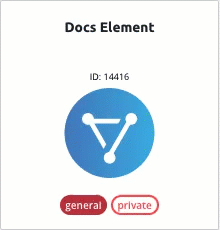Salesforce Sales Cloud
Authenticate with Salesforce
You can authenticate with Salesforce to create your own instance of the Salesforce Sales Cloud element through Cloud Elements or through APIs. Once authenticated, you can use the element instance to access the different functionality offered by the Salesforce Sales Cloud platform.
Authenticate Through the UI
Use Cloud Elements to authenticate with Salesforce and create an element instance. Salesforce authentication follows the typical OAuth 2 framework and you will need to sign in to Salesforce as part of the process.
If you are configuring events, see the Events section.
- Sign in to Cloud Elements, and then search for Salesforce Sales Cloud in our Elements Catalog.

- Hover over the element card, and then click Authenticate.

Enter a name for the element instance.
Note: If connecting to a Salesforce sandbox, change the optional Endpoint Address to https://test.salesforce.com.Click Create Instance.
Provide your Salesforce credentials, and then allow the connection.
After successfully authenticating, we give you several options for next steps. Make requests using the API docs associated with the instance, map the instance to a virtual data resource, or use it in a formula template.
Authenticate Through API
Authenticating through API is a multi-step process that involves:
- Getting a redirect URL. This URL sends users to the vendor to log in to their account.
- Authenticating users and receiving the authorization grant code. After the user logs in, the vendor makes a callback to the specified url with an authorization grant code.
- Authenticating the element instance. Using the authorization code from the vendor, authenticate with the vendor to create an element instance at Cloud Elements.
Getting a Redirect URL
Use the following API call to request a redirect URL where the user can authenticate with the vendor. Replace {keyOrId} with the element key, sfdc.
GET /elements/{keyOrId}/oauth/url?apiKey=<api_key>&apiSecret=<api_secret>&callbackUrl=<url>&siteAddress=<url>
Query Parameters
| Query Parameter | Description |
|---|---|
| apiKey | The key obtained from registering your app with the provider. This is the Consumer Key that you noted at the end of the Endpoint Setup section. |
| apiSecret | The secret obtained from registering your app with the provider. This is the Consumer Secret that you noted at the end of the Endpoint Setup section. |
| callbackUrl | The URL that will receive the code from the vendor to be used to create an element instance. This is the Callback URL that you noted at the end of the Endpoint Setup section. |
| siteAddress | OptionalIf using a sandbox account, specify a site address of http://test.salesforce.com. Otherwise, the default http://login.salesforce.com is used. |
Example cURL
curl -X GET
-H 'Content-Type: application/json'
'https://api.cloud-elements.com/elements/api-v2/elements/sfdc/oauth/url?apiKey=fake_salesforce_api_key&apiSecret=fake_salesforce_api_secret&callbackUrl=https://www.mycoolapp.com/auth&state=sfdc'
Example Response
Use the oauthUrl in the response to allow users to authenticate with the vendor.
{
"element": "sfdc",
"oauthUrl": "https://login.salesforce.com/services/oauth2/authorize?response_type=code&client_id=fake_salesforce_api_key&client_secret=xyz789&scope=full%20refresh_token&redirect_uri=https://www.mycoolapp.com/auth&state=sfdc"
}
Authenticating Users and Receiving the Authorization Grant Code
Provide the response from the previous step to the users. After they authenticate, the endpoint provides an authorization grant code and state as query parameters, as shown in the example below.
https://<callbackurl>?code=xoz8AFqScK2ngM04kSSM&state=sfdc
Query Parameters
| Query Parameter | Description |
|---|---|
| code | The code required by Cloud Elements to retrieve the OAuth access and refresh tokens from the endpoint. |
| state | The element key (sfdc) . |
error instead of the code parameter. In this case, your application can handle the error gracefully.Authenticating the Element Instance
Use the /instances endpoint to authenticate with Salesforce and create an element instance. If you are configuring events, see the Events section.
To create an element instance:
Construct a JSON body as shown below (see Parameters):
{ "element": { "key": "sfdc" }, "providerData": { "code": "<AUTHORIZATION_GRANT_CODE>" }, "configuration": { "oauth.callback.url": "<CALLBACK_URL>", "oauth.api.key": "<CONSUMER_KEY>", "oauth.api.secret": "<CONSUMER_SECRET>", "filter.response.nulls": true }, "tags": [ "<Add_Your_Tag>" ], "name": "<Insert_Instance_Name>" }Call the following, including the JSON body you constructed in the previous step:
POST /instancesNote: Make sure that you include the User and Organization keys in the header. See the Overview for details.Locate the
tokenin the response and save it for all future requests using the element instance.
Example cURL
curl -X POST \
https://api.cloud-elements.com/elements/api-v2/instances \
-H 'authorization: User <USER_SECRET>, Organization <ORGANIZATION_SECRET>' \
-H 'content-type: application/json' \
-d '{
"element": {
"key": "sfdc"
},
"providerData": {
"code": "xoz8AFqScK2ngM04kSSM"
},
"configuration": {
"oauth.callback.url": "<CALLBACK_URL>",
"oauth.api.key": "<CONSUMER_KEY>",
"oauth.api.secret": "<CONSUMER_SECRET>"
},
"tags": [
"For Docs"
],
"name": "SFDCviaAPI1"
}'
Parameters
API parameters not shown in Cloud Elements are in code formatting.
| Parameter | Description | Data Type |
|---|---|---|
| 'key' | The element key. sfdc |
string |
Namename |
The name for the element instance created during authentication. | Body |
oauth.callback.url |
The Callback URL from Salesforce. This is the Callback URL that you noted at the end of the Endpoint Setup section. | |
oauth.api.key |
The Consumer Key from Salesforce. This is the Consumer Key that you noted at the end of the Endpoint Setup section | string |
oauth.api.secret |
The Consumer Secret from Salesforce. This is the Consumer Secret that you noted at the end of the Endpoint Setup section | string |
Filter null values from the response filter.response.nulls |
Optional. Determines if null values in the response JSON should be filtered from the response. Yes or true indicates that Cloud Elements will filter null values. Default: true. |
boolean |
| tags | Optional. User-defined tags to further identify the instance. | string |
Example Response
{
"id": 123,
"name": "test",
"token": "3sU/S/kZD36BaABPS7EAuSGHF+1wsthT+mvoukiE",
"element": {
"id": 39,
"name": "Salesforce.com",
"key": "sfdc",
"description": "The Salesforce.com allows you to deliver revolutionary CRM automation functionality, such as account and contact creation, from anywhere, anytime, on any device.",
"active": true,
"deleted": false,
"typeOauth": true,
"trialAccount": false,
"configDescription": "If you do not have a Salesforce.com account, you can create one at Salesforce.com Signup</a>",
"signupURL": "http://www.salesforce.com"
},
"provisionInteractions": [],
"valid": true,
"eventsEnabled": true,
"disabled": false,
"maxCacheSize": 0,
"cacheTimeToLive": 0,
"cachingEnabled": false
}